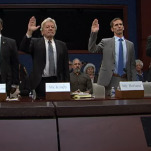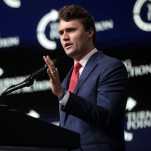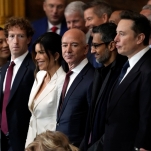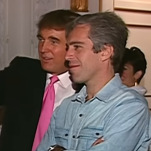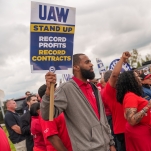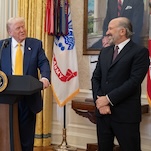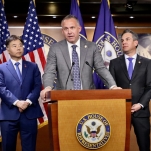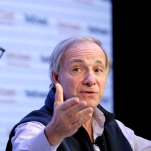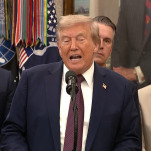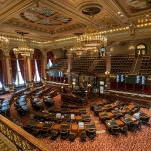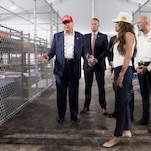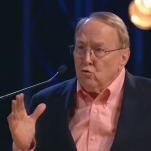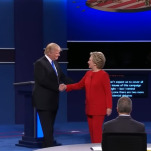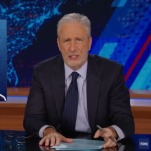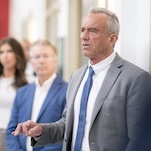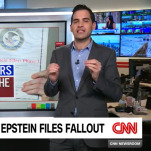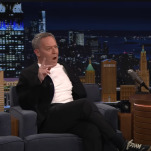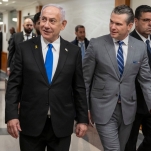Inside Jesse Jackson's years-long push for diversity in Silicon Valley
Silicon Valley’s diversity problem might seem obvious today. But it took years of public pressure, led by Reverend Jesse Jackson’s civil rights group, to get tech giants to admit they had a problem and to reveal the demographics of their workforces. And that group is still trying to get the giants to make concrete commitments to hire more women and people of color in order to “face the change and change the face” of Silicon Valley.
For nearly five decades, Jackson has been pushing American business leaders to diversify their work forces. His organization, RainbowPUSH, initially targeted traditional American industry titans in banking and manufacturing. But during the tech boom of the late 1990s, Jackson realized that he also needed to apply pressure to the giants of the tech economy.
To lead his Digital Connections project, Jackson tapped a former Berkeley student named Lyle “Butch” Wing. Jackson and Wing’s Silicon Valley campaign started in 1999 at the Children’s Discovery museum in San Jose. In a recent interview with Fusion, Wing said that about 75 people attended that meeting; the attendees included African American entrepreneurs and representatives from Intel and Sun Microsystems. A year later, Rev. Jackson and the RainbowPUSH Coalition held another meeting with the heads of Intel, Cisco, HP, Covad, Symantec and Agilent , who gathered to discuss the need to diversify in the Valley. (After the 2000 meeting, the entire group attended a barbecue at the Woodside home of John Thompson, who is currently the CEO of Virtual Instruments for Microsoft and one of the few black executives in Silicon Valley.) Since then, Wing has spent 15 years making pilgrimages with Jackson to Silicon Valley, visiting shareholder meetings and the offices, homes, and backyard barbecues of tech company executives to exhort them to hire more diverse work forces.
One of the demands RainbowPUSH made for over a decade was for tech companies to reveal their employee demographics. And in 2014, many companies did. LinkedIn, Microsoft, Apple, Pandora, Indiegogo, Comcast, Facebook, Google, HP, and Twitter all published their race and gender diversity numbers for the first time, revealing—surprise!—workforces that were largely white and male.
But it was a start; you have to admit you have a problem before you can fix it. As of January of 2015, Forbes could only list six major tech companies that hadn’t released their data: IBM, Oracle, EMC, Broadcom, SanDisk and Qualcomm. And following RainbowPUSH’s lead, tech executives have begun to talk openly about the need for diversity of all kinds.
Last August, Facebook COO Sheryl Sandberg called the current status quo “pretty depressing.” Microsoft CEO Satya Nadella said, “We must ensure not only that everyone receives equal pay for equal work, but that they have the opportunity to do equal work.” And Intel CEO Brian Krzanich said, “Without a workforce that more closely mirrors the population, we are missing opportunities, including not understanding and designing for our own customers.”
The RainbowPUSH Coalition’s goal is to create a Silicon Valley that is representative of the demographics of America. “We want to do this by 2020. And we’re going to put a budget around it,” said Wing. He points out that a lot of these companies have a diverse consumer base, so it would behoove them to have a diverse workforce. Wing believes by showing companies that there is an economic benefit to creating a diverse Silicon Valley, plus using “goals, targets, and timetables,” things will change.
In December 2014, RainbowPUSH held meetings with high-ranking officials from Microsoft, Apple and Intel. In an interview, Wing wouldn’t reveal much about the content of the C-suite conversations. But it’s likely that Jackson, who has been an activist since the 1960s—when he marched alongside Martin Luther King, Jr., incorporated some of the tactics that date back to that era to pressure tech companies into coughing up information about their employee demographics. He has two big weapons in his arsenal: the law and the power of the media. There’s a federal civil rights law that requires American companies with more than 100 employees to release data on the demographics of its workforce. But Silicon Valley companies fought it for years, even taking it to court, complaining that exposing this information would put them at a competitive disadvantage. Last year, tech companies finally gave in and started publishing the numbers.
RainbowPUSH’s other tactic is old-fashioned shareholder activism. RainbowPUSH launched the Wall Street Economic Project in the 1990s to encourage people of color to get more involved in the financial industry; as part of the project, the Coalition bought a small amount of stock in a number of early Silicon Valley businesses, which allowed them to attend and speak at those companies’ annual shareholder meetings. These confrontations have paid dividends; at Microsoft’s shareholder meeting in 2014, Jackson demanded that the company release its diversity numbers. A month later, the numbers were published on the company’s website.
-

-

-

-

-

-

-

-

-

-

-

-

-

-

-

-

-

-

-

-

-

-

-

-

-

-

-

-

-

-

-

-

-

-

-

-

-

-

-

-

-

-

-

-

-

-

-

-

-

-

-

-

-

-

-

-

-

-

-

-

-

-

-

-

-

-

-

-

-

-

-

-

-

-

-

-

-

-

-

-

-

-

-

-

-

-

-

-

-

-

-

-

-

-

-

-

-

-

-

-

-

-

-

-

-

-

-

-



